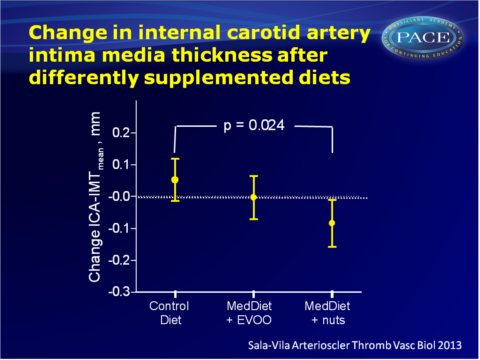Favourable changes in carotid artery intima media thickness with Mediterranean diet plus nuts
PREDIMED: Following a Mediterranean diet supplemented with nuts seems a sound strategy to delay progression of atherosclerosis.
Changes in Ultrasound-Assessed Carotid Intima-Media Thickness and Plaque With a Mediterranean Diet: A Substudy of the PREDIMED TrialLiterature - Sala-Vila A et al., ATVB 2013 - Arterioscler Thromb Vasc Biol. 2013 Nov 27
Sala-Vila A, Romero-Mamani ES, Gilabert R, et al.,
Arterioscler Thromb Vasc Biol. 2013 Nov 27. [Epub ahead of print]
Background
The Prevención con Dieta Mediterránea (PREDIMED) trial has previously shown that a Mediterranean diet (MedDiet) supplemented with either extra virgin olive oil (EVOO) or 30 g/d of mixed nuts reduced incident cardiovascular (CV) events with 30%, as compared to a control (low fat) diet. In the PREDIMED study, 7447 participants at high CV risk but without CV disease at enrolment, were followed for a mean of 4.8 years, in which the incidence of a composite end point of CV death, myocardial infarction and stroke was documented [1].The underlying biological mechanisms via which EVOO and nuts protect against CVD remains to be uncovered. Their favourable fatty acid profile and richness in bioactive phytochemicals with antioxidant and anti-inflammatory properties suggests that they exert an antiatherogenic effect [2-4].
Artery vessel wall enlargement is an early feature of atherosclerosis that can be evaluated by ultrasound determination of carotid artery intima-media thickness (IMT)[5]. In a previous PREDIMED substudy, participants with a high carotid atherosclerotic burden who followed the MedDiets supplemented with EVOO or nuts showed regression of mean common carotid artery (CCA)-IMT after 1 year, as compared to the control diet [6]. Evidence now exists that IMT of the internal carotid artery (ICA) is more representative of atherosclerosis and better predict CVD than CCA-IMT [7,8]. Thus, this study analyses maximum ICA-IMT and plaque height in subjects at high vascular risk who were randomised to a MedDiet supplemented with EVOO (n=55) or nuts (n=42) or a control diet (n=58), and who were followed for over 2 years.
Main results
- Participants in the control group showed a significant progression of ICA-IMT(max) (0.188 mm 95%CI: 0.077-0.299) and plaque (max) (0.106 mm, 95%CI: 0.001-0.210).
Participants allocated to MedDiet with nuts showed a significant regression in ICA-IMT(mean) (-0.084 mm, 95%CI: -0.158 to -0.010) or arrested progression (ICA-IMT(Max)[ -0.030, 95%CI: -0.153 to 0.093] and plaque(max)[ -0.091 mm, 95%CI: -0.206 to 0.023].
No significant changes were seen in participants who followed the MedDiet with EVOO. - Change in plaque (max) was only significantly determined by allocation into the MedDiet+nuts group as compared to the control diet group (B= -0.0198, 95%CI: -0.343 to -0.054, P=0.008), use of anti-hypertensive drugs at baseline (B=0.132, 95%CI: 0.001 to 0.263, P=0.048) and baseline plaque(max) (B= -0.137, 95%CI: -0.217 to – 0.057, P=0.001).
- Changes in objective biomarkers were mean increases from baseline to end of the trial of 0.10% for plasma α-linolenic acid in the MedDiet with nuts group and of 337 μg/L in urinary hydroxytyrosol in the MedDiet with EVOO group (P=0.003 versus control diet group for both), respectively, indicating good compliance with the supplemental foods.
Download Sala-Vila NUTS 2013 PACE.pptx

Conclusion
This randomised study shows that an intervention with a MedDiet supplemented with 30 g/day of mixed nuts for a mean of 2.4 years induced regression of ICA-IMT (mean) and delayed the progression of both ICA-IMT(max) and plaque(max). No changes were seen in participants who followed the MedDiet supplemented with EVOO, but progression of ICA-IMT(max) and plaque(max) was observed in the control group.Delayed IMT and plaque progression may in part explain the reduction of CVD events, in particular stroke, previously observed in the nut-supplemented arm of the PREDIMED trial. Diets rich in polyunsaturated fats and bioactive molecules from plant sources may delay atherosclerosis progression, thereby likely reducing plaque vulnerability.
Find this article on Pubmed
References
1. Estruch R, Ros E, Salas-Salvadó J, et al. Primary prevention of cardiovascular disease with Mediterranean diets. N Engl J Med. 2013;368:1279–1290.
2. López-Miranda J, Pérez-Jiménez F, Ros E, et al. Olive oil and health: summary of the II international conference on olive oil and health consensus report, Jaén and Córdoba (Spain) 2008. Nutr Metab Cardiovasc Dis. 2010;20:284–294.
3. Ros E, Mataix J. Fatty acid composition of nuts–implications for cardiovascular health. Br J Nutr. 2006;96(suppl 2):S29–S35.
4. Urpi-Sarda M, Casas R, Chiva-Blanch G, et al. Virgin olive oil and nuts as key foods of the Mediterranean diet effects on inflammatory biomarkers related to atherosclerosis. Pharmacol Res. 2012;65:577–583.
5. de Groot E, van Leuven SI, Duivenvoorden R, et al. Measurement of carotid intima-media thickness
to assess progression and regression of atherosclerosis. Nat Clin Pract Cardiovasc Med. 2008;5:280–288.
6. Murie-Fernandez M, Irimia P, Toledo E, et al; PREDIMED Investigators. Carotid intima-media thickness changes with Mediterranean diet: a randomized trial (PREDIMED Navarra). Atherosclerosis. 2011;219:158–162.
7. Polak JF, Pencina MJ, Pencina KM, et al. Carotid-wall intima-media thickness and cardiovascular events. N Engl J Med. 2011;365:213–221.
8. Inaba Y, Chen JA, Bergmann SR. Carotid plaque, compared with carotid intima-media thickness, more accurately predicts coronary artery disease events: a meta-analysis. Atherosclerosis. 2012;220:128–133.
